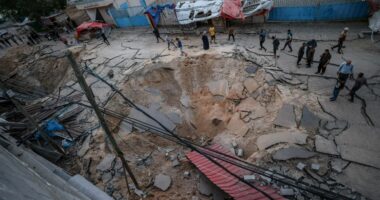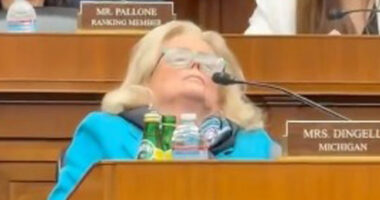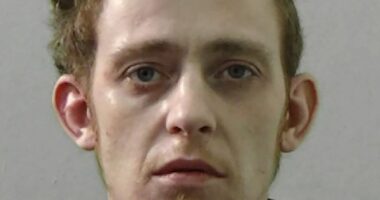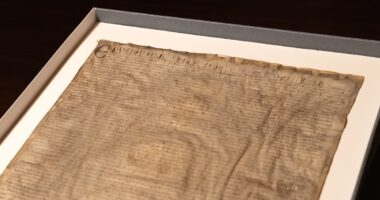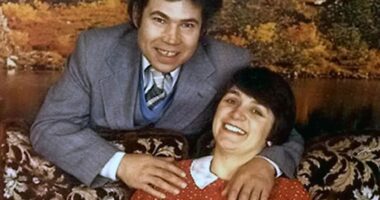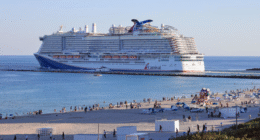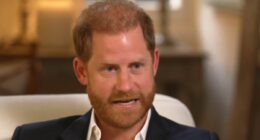The crew of the ill-fated Bayesian superyacht were not aware of its vulnerabilities to extreme winds, which ultimately led to it toppling over and sinking, according to British investigators.
The 184ft vessel overturned near Sicily in August last year, resulting in the tragic loss of seven lives, including British billionaire, Mike Lynch, and his 18-year-old daughter, Hannah.
The Marine Accident Investigation Branch (MAIB) revealed that the £30 million yacht was fatally impacted when winds of 80.6mph hit its side, causing it to tilt sharply to a 90-degree angle.
Preliminary investigations shows that wind speeds of 63.4 knots (73mph) directly on the vessel’s beam would ‘likely result in the vessel capsizing’.
The interim report that ‘vulnerabilities’ were ‘unknown to either the owner or the crew of Bayesian’ as they were not included in the stability information book carried on board.
Andrew Moll, Chief Inspector of Marine Accidents, said: ‘The findings indicate that the extreme wind experienced by Bayesian was sufficient to knock the yacht over.
‘Further, once the yacht had heeled beyond an angle of 70 degree the situation was irrecoverable.’
Giovanni Costantino, CEO of the Bayesian’s builders The Italian Sea Group, has previously said the sinking was ‘down to human error’ and insisted that it was ‘unsinkable’.

The Bayesian, pictured left, capsized and sunk off the coast of Sicily after anchoring near Porticello to shelter from the forecast thunderstorm

The chart from the interim report shows the location and drift of the yacht Bayesian in comparison to the Sir Robert Baden Powell when both were hit by a storm

The graphic shows the floorplan of the 184ft vessel £30million yacht which is yet to be recovered from the seabed

The tragedy last August killed seven people including the owner of the superyacht British billionaire and tech tycoon Mike Lynch and his daughter Hannah
The detailed report provides an agonising breakdown of events, charting for the first time how the tragedy unfolded minute by minute off the coast near Porticello.
The MAIB have said however that this is an interim report based on limited verified evidence.
On the night of August 18, the Bayesian had anchored next to the Sir Robert Baden Powell -a boat which would later rescue survivors – to shelter from the forecast thunderstorm.
At 3am, the deckhand on duty noted the wind as being at 8kts (9.2pmh) but thought that the thunderclouds and lightning seemed to be getting closer.
Less than an hour later at 3.55am, the deckhand ‘videoed the advancing storm and posted it to their social media feed’ before closing hatches and cockpit windows.
Within minutes the winds had picked up to 30kts (35mph) and the Bayesian was listing and dragging its anchor.
At around 4am, the deckhand woke up the skipper and the crew leapt into action by starting the generators and preparing to manoeuvre the Bayesian.
Meanwhile a British mother and her partner woke up and took their one-year-old daughter to the boat’s saloon.
The chef Recaldo Thomas, who would die in the tragedy, was in the galley securing the cutlery, pots and pans and called ‘Good morning!’ to the nearby stewards.
But as disaster struck as the skipper prepared to manoeuvre, the wind suddenly increased to more than 70kts (80.5mph) ripping the awning away.
At 4.06am the Bayesian ‘violently heeled over’ in less than 15 seconds to a 90-degree angle.

The Marine Accident Investigation Branch (MAIB) said the £30m yacht was compromised when 80.6mph winds struck its beam, causing it to heel violently

The moment the doomed Bayesian sank in the early hours of August 19 was captured by security cameras of a nearby villa on the coast

The interim report found that the weather on the night of the sinking was enough to tip the Bayesian over

An operation to float the Bayesian started in recent weeks

Jonathan Bloomer, 70, and his wife Judy, 71, from Kent, were among the seven people who died when the 56 meter sailing boat sank
This sent people as well as furniture flying across the deck leaving five people including the captain were injured while a deckhand was thrown into the sea.
Two guests trapped in their cabin were forced to used furniture drawers as an improvised ladder to escape into the saloon area.
The report said there was no indication of flooding inside the vessel until water came in over the starboard rails and, within seconds, entered the cabins down the stairwells.
The yacht’s crew were able to push four guests through the cascading water up to the skipper on the flying bridge.
The Chief Officer who had been swept to the back of the saloon and into another air pocket, dived down to open the sliding doors at the end of the saloon and managed to swim clear of the vessel.
The captain called for the guests and crew who managed to escape to swim clear of the mast and boom as the vessel sank.
In the water, a deckhand improvised a tourniquet for a one of the guest’s gashed arms, while a baby was kept afloat on a cushion.
In the darkness, some of survivors were treading water while others held on to some cushions that had floated free from the yacht.

An undated photo of the tragic yacht

Hannah and Mike Lynch perished on the superyacht
One of the guests frantically searched for other survivors in vain using the torch from their phone while the captain and chief officer frantically freed the life raft from the sinking wreck.
At around 4.24am the liferaft was inflated and the survivors were able to get inside it where the crew began administering first aid.
Desperate to raise the alarm with the nearby Sir Robert Baden Powell, the chief engineer fired several flares before they were spotted at 4.43am.
The skipper of Sir Robert Baden Powell dispatched its tender towards the 15 survivors and despite searching the area no one else was found.
The bodies were subsequently recovered after an agonising five-day search of the wreck on the seabed.
Morgan Stanley International bank chairman Jonathan Bloomer, 70, and his wife, Judy Bloomer, 71, US lawyer Chris Morvillo and his wife Neda Morvillo were among the dead.
The MAIB said its ongoing investigation is based on ‘a limited amount of verified evidence’ as a criminal investigation by Italian authorities has restricted access to the wreck and other evidence.
A project to recover the Bayesian is set to resume on Thursday after a diver died during underwater work.
How the Bayesian tragedy unfolded minute by minute:
August 18 – PM – The Bayesian was anchored at Cefalù on the northern coast of Sicily to shelter from the forecast weather and to allow for easy disembarkation of guests the following day.
August 19 – 00.30am – Having checked the weather the captain and the last guest had retired, leaving deckhand (DH1) and the evening steward (S1) on duty.
01.00am – The second deckhand (DH2) took over the watch. The wind at this time was noted as being no more than 8kts (9.2pmh).
03.00am – DH2 noted the wind as being at 8kts (9.2pmh) from the west but thought that the thunderclouds and lightning seemed to be getting closer.
03.55am – The deckhand ‘videoed the advancing storm and posted it to their social media feed’ before closing the hatches and cockpit windows.
03.57am – The winds had picked up to 30kts (35mph) and the Bayesian was listing and dragging its anchor.
04.00am – The deckhand ran to wake up the skipper and the crew leapt into action and began preparing to manoeuvre the Bayesian by starting the generators and steering pumps.
The rest of the crew, woken by either the captain or the yacht’s change of motion, got up and made their way out of the crew accommodation.
Chef Recaldo Thomas was spotted in the galley stowing cutlery, pots and pan and called out ‘Good morning!’ to nearby stewards.
The Bayesian was lying with the wind about 60 degree off the port bow and moving at 1.8kts south-south-east of its original position.
Two guests – a British couple – had been woken by the movements and decided to head to the saloon with their baby.
4.06am – Disaster struck as the wind suddenly increased to more than 70kts (80.5mph) ripping the awning away. The Bayesian ‘violently heeled over’ in less than 15 seconds to a 90-degree angle.
The sudden movement sent people as well as furniture flying across the deck leaving five people including the captain injured while a deckhand was thrown into the sea.
Two guests trapped in their cabin were forced to used furniture drawers as an improvised ladder to escape into the saloon area.
The yacht’s crew were able to push four guests through the cascading water up to the skipper on the flying bridge.
The captain called for the guests and crew to swim clear of the mast and boom as the vessel sank.
04.22am – The crew had launched the Emergency Position Indicating Radio Beacons (EPIRB). They noted that the wind had eased and that Bayesian was only a short distance from shore.
In the water, a deckhand(DH2) improvised a tourniquet for one of the guest’s gashed arm while a cushion was used as a flotation device foe the baby. Some of the survivors were treading water and others held on to some cushions that had floated free from Bayesian.
One of the guests frantically searched for other survivors in vain using the torch from their phone – while the captain and chief officer frantically freed the life raft from the sinking wreck.
04.24am – The captain and chief officer frantically freed the life raft from the sinking wreck. It was was inflated and the survivors were able to get inside it where the crew began administering first aid.
The skipper tried to raise the alarm by shouting at and then paddling towards the nearby vessel the Sir Robert Baden Powell.
04.34am – The Chief Engineer fired a red parachute flare from the liferaft. Despite the winds being calm at the surface, the flare was carried sideways. He then used the liferaft’s torch to signal towards a hotel on the cliffs above them, passing cars, and Sir Robert Baden Powell.
04.43am – The Chief engineer fired a second parachute flare that was seen by the crew of Sir Robert Baden Powell. Responding to the flare, the skipper dispatched its tender towards the visible lights of the EPIRB and liferaft.
04.53am – The tender carrying the 15 survivors returned to Sir Robert Baden Powell and a brief search was look for the missing seven people who were also on board.
04.56am – the tender from Sir Robert Baden Powell returned to the scene with Bayesian’s Chief Engineer and skipper on board to search for other survivors. The local coastguard was called to arrange to transfer the survivors to shore.





